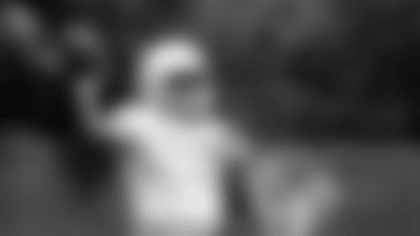Texans strength and conditioning coach **Dan Riley** writes his popular Fitness Corner column for HoustonTexans.com. Riley and assistant
strength and conditioning coach **Ray Wright** will continue to post selected answers to your questions throughout the year.
Join in by shooting over an e-mail to **fitness@houstontexans.com**.
Here's Dan...
*
*I am the Athletic Director and Strength Coach at Wilkes Central High School in
North Carolina. I am preparing to train ten of our football players in a negative
only manner. There appears to be very little information available in the area
of negative only training. I have found some work done by Arthur Jones and Ellington
Darden but little else. What is your opinion of negative only exercise? Do you
currently use any form of negative training with your players and if so, how is
it performed? **
My first exposure to negative only exercise was at West Point during one of the many studies the Academy conducted to determine the effects strength training had on the physical performance of cadets.* *Arthur Jones and Ellington Darden supervised several of these studies using various forms of negative enhanced training techniques.
I was amazed at how effective negative only exercise produced strength gains. Negative only exercise may be one of the most productive forms of exercise available if properly utilized.
Heavier weights can be used during negative only training which is why strength gains are so significant. I would recommend some caution if you have never used negative only exercise. It is the lowering phase of an exercise that causes the most muscle soreness. Negative only exercise can cause some serious muscle soreness. My advice to a beginner is ease into negative only training. Start out light and gradually add weight each succeeding workout.
During normal exercise a muscle contracts concentrically during the raising phase. We call this "positive" work. During the lowering phase of an exercise, a muscle lengthens eccentrically, and this is called "negative" work.
During negative only exercise the lifter onlylowers the weight. Special equipment or well-trained spotters are needed to raise the weight for the lifter.
Negative only exercise is often confused with the term "negatives." Negatives are performed when a lifter reaches the point when he can no longer lift the weight (perform another positive rep).
The spotter will then help the lifter raise the weight for a few extra reps. Instead of "negatives" we use the term "forced reps."
An athlete can lower a great deal more weight than he can lift. During normal exercise an athlete is limited to how much weight he will lower by the amount of weight he can lift. More strength could be gained from the lowering of a weight if heavier weights were used during the lowering phase.
Better strength gains could be made if we added more weight after our players lifted the weight. This would allow them to use a heavier weight during the lowering phase of the exercise. In theory this makes sense but it is not very practical to keep adding weight and taking it off every repetition.
The only practical way to obtain near maximum strength gains from the lowering phase of an exercise is to perform a variation of one of the following:
- Negative Only Exercise
- Negative Accentuated Exercise
- Negative Emphasized Exercise
In today's installation of the Fitness Corner I will focus on negative only exercise. I have experimented with negative only exercise for many years. Player feedback through the years has helped me determine the safest and most productive protocol for our Texans. A big thanks to linebacker Troy Evans for his help in demonstrating the negative only exercise routine.
We use the following techniques when performing negative only exercise.
- The spotter must use a stopwatch and sound off with a verbal cadence of eight-second reps. This will insure that the lifter is taking precisely eight seconds to lower the weight.
- The spotter waits to begin counting until the lifter initiates the lowering phase.
- The lowering speed must be consistent from start to finish.
- Allow eight seconds per repetition.
- Perform eight repetitions (total of sixty-four seconds of exercise).
- Add more weight when the lifter can safely and properly perform eight good repetitions.
Our players currently perform the following exercises in a negative only fashion:
- Negative only dips (start-finish)
- Negative only chin-ups (start-finish)
- Negative only bench press (start-finish)
Negative Only Dips
*
*
 |
 |

Once an athlete can properly perform eight negative only reps with his bodyweight
he must increase the resistance (if his goal is to get stronger). We use a weight
belt and barbell plates to accomplish this.

To perform a negative only dip the athlete uses steps on our chin/dip machine
to recover to the starting position. Do not stall or waste time recovering to
the starting position to begin the next rep. Taking too much time to start the
next rep will allow the muscles too much recovery time.
We ask our players to gently (not suddenly) ease off the steps one foot at a
time. This procedure will help prevent the body from swinging back and forth.
In the starting position the arms should be slightly bent (not locked out) with
the head looking downward. During the entire lowering phase we ask our players
to make this exercise feel like a decline press or a push-up.
As soon as the athlete begins the lowering phase the spotter starts the eight-second count. The lifter must take eight seconds from the starting position to the finish. The athlete must then quickly and safely return to the starting position.
You can amplify the intensity of exercise for a particular muscle group by pre-exhausting it with an isolation exercise followed immediately by negative only dips.
For example we often have our players perform an isolation exercise for the chest
muscles followed immediately by negative only dips. This will enhance the intensity
of exercise for the chest muscles (see below).
 |
 |
For some variety for the arms we will sometimes pre-exhaust the triceps with an isolation exercise and then immediately perform negative only dips. This will amp up the intensity for the triceps (see below).
 |
 |
*
Negative Only Chin-ups/Pull-ups *
 |
 |
The same rules apply for a chin-up/pull-up as they do for Negative Only Dips. Once an athlete can properly lower his bodyweight for eight chin-ups he must begin adding more resistance (if his goal is to get stronger).
The athlete uses the steps on our chin/dip machine to recover to the starting position. Once the chin is positioned over the bar, gently step off each step, one foot at a time. This will help prevent the body from swinging back and forth and/or dropping suddenly.
It will also allow a more subtle transition of the bodyweight to the smaller muscles of the arms. The chin must remain over the bar for a count of 1001 before beginning the lowering phase.
Use a smooth and consistent lowering speed throughout the lowering phase. Allow eight-seconds from the starting position to the arms extended position. Safely and quickly recover to the starting position to begin the next rep.
Point of emphasis: Do not hop or jump off the steps into the starting position. This will cause the body to drop suddenly. Make this transition a very smooth one.
To amplify the intensity of exercise for the upper back muscles we have our players
perform an isolation exercise for the upper back followed immediately with a set
of negative only chin-ups. This protocol will significantly enhance the intensity
of exercise for the muscles of the upper back. (see below)
 |
 |
Another option is to perform a hard set of biceps curls followed immediately with a set of negative only chin-ups. This will make for a very interesting day or two for your biceps, especially if you are able to finish all eight reps (see below).
**
 |
 |
*
*Negative Only Bench Press **
I prefer using a Smith Machine to perform the negative only bench press because it is safer and so much easier to spot than a barbell. With a barbell the spotters must be capable of raising a very heavy weight and simultaneously handing it off to the lifter without causing any balance problems for the lifter.
With a Smith Machine we can also quickly strip plates (decrease the weight) during the set if a weight gets too heavy and not have to worry about the lifter losing his balance.
To execute the exercise the lifter lowers the bar allowing eight seconds from
the arms extended position until the bar barely touches the chest (see below).
 |
 |
The spotters (without assistance from the lifter) will then raise the weight to the original starting position. The spotters must carefully and simultaneously hand the weight to the lifter for the execution of the next rep (see below).
 |
 |
For variety we will pre-exhaust the chest muscles with an isolation exercise for the chest followed immediately with eight reps of the negative only bench press.
Negative only exercise is a very demanding form of exercise and possibly too demanding for some people. We currently use negative only training to add some variety to our standard routines.
If you want to add something positive to your workouts try some negative training to juice things up a little bit.













